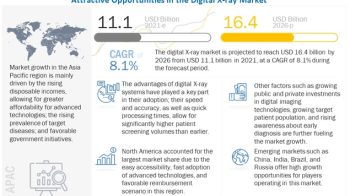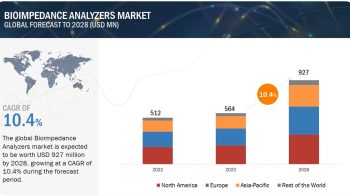The report “Process Analytical Technology Market as measured by revenue, was valued at approximately $3.2 billion in 2022. Projections indicate that it is on track to attain a valuation of around $6.1 billion by 2027, showcasing a robust Compound Annual Growth Rate (CAGR) of 13.8% spanning from 2022 to 2027. The recent research analysis encompasses a comprehensive examination of industry trends, encompassing aspects such as pricing, patents, conferences, webinars, key stakeholders, and consumer purchasing patterns within the market.
The upward trajectory of this market can be attributed to several key drivers. Notably, there has been a notable surge in both direct and indirect financial investments directed towards analytical instruments. Simultaneously, strategic collaborations aimed at enhancing drug discovery processes have contributed significantly to market growth. The global biosimilar market’s expansion has further bolstered this growth, as has the prevalence of conferences and symposia centered around advancements in analytical technologies.
Download PDF Brochure: https://www.marketsandmarkets.com/pdfdownloadNew.asp?id=59564006
Browse in-depth TOC on “Single Cell Analysis Market”
132 – Tables
42 – Figures
209 – Pages
Key Market Players
The process analytical technology market is competitive in nature with several big and emerging players equally holding shares of the market. As of 2021, the key players operating in the global process analytical technology market are Thermo Fisher Scientific, Inc. (US), Danaher Corporation (US) , Agilent Technologies, Inc. (US), Shimadzu Corporation (Japan), Waters Corporation (US), Bruker Corporation (US), Emerson Electric Co. (US), ABB Ltd. (Switzerland), PerkinElmer, Inc. (US), Mettler-Toledo International Inc. (US), and Carl Zeiss AG (Germany), among others.
Process Analytical Technology Market Dynamics
Driver: Rising need for quality improvements in manufacturing processes
PAT instruments are robust tools used to analyze and control Critical Quality Attributes (CQAs) in pharmaceutical and biopharmaceutical manufacturing processes by measuring Critical Process Parameters (CPPs). These tools are implemented to increase the efficiency of the production process to obtain quality products and improve the final product’s overall performance. PAT allows continuous monitoring of pharmaceutical production by generating real-time product quality information and reduces final batch discarding or reprocessing. The technology aids in controlling costs in the manufacturing process and provides financial benefits through faster product release by eliminating post-production testing. It also reduces the cycle time and energy consumption to run the equipment. Automation in the process thus reduces the overall labor cost.
These benefits of PAT in improving manufacturing process efficiencies are expected to drive market growth during the forecast period.
Request 10% Customization: https://www.marketsandmarkets.com/pdfdownloadNew.asp?id=59564006
Restraint: High cost of PAT deployment
The technological developments have increased the prices of these systems. For instance, the cost of a new spectroscopy instrument may vary from USD 75,000 to USD 500,000. The price for an HPLC system ranges from USD 10,000 to USD 40,000, while a dynamic light-scattering particle size analyzer may cost around USD 30,000 to USD 60,000, depending on the associated accessories. Despite the operational and cost-saving benefits of PAT implementation in the pharmaceutical industry, its adoption has been slow in emerging economies.
Opportunity: Emerging markets
Emerging Asian markets such as China, South Korea, Indonesia, and India are expected to offer significant growth opportunities for PAT. This can primarily be attributed to the presence of less-stringent regulatory policies, an increasing number of pharmaceutical companies, the availability of a skilled workforce, and government initiatives to boost local manufacturing. Countries such as China and India present various opportunities for the growth of the market. China and India generate a huge demand for devices such as spectrometers and chromatography instruments due to the Greenfield projects being set up in various end-user industries in these countries. The biopharmaceutical industry in these countries is robust and is expected to contribute largely to the growth of the spectroscopy and chromatography markets in the coming years.
Molecular spectroscopy segment to register significant growth rate over the forecast period.
Based on the type of technology, the global PAT market has been classified into five major segments—spectroscopy, chromatography, particle size analysis, capillary electrophoresis, and other technologies. The spectroscopy segment is further sub-segmented into molecular spectroscopy, mass spectrometry, and atomic spectroscopy. The molecular spectroscopy segment is anticipated to register significant growth. In the pharmaceutical industry, molecular spectroscopy has numerous applications, such as quantitative analysis of pharmaceutical substances, pathogen detection, protein quantification, biochemistry, and biophysics research. The wide application area of this technology and the presence of stringent regulatory guidelines for drug development and safety are the major factors driving the growth of the global molecular spectroscopy market.
Products segment accounted for the largest share of the process analytical technology market, by product & service market.
The product segment dominates the process analytical technology market, and the trend is expected to continue over the forecast period. This segment held the largest share owing to the technological advancements in process analytical techniques that offer operational efficiency and reduce the process cycle time.
On-line analysis segment dominated the market in terms of measurement.
Process analytical technology tools are used for the timely measurement of Critical Process Parameters (CPP) during the development and manufacturing of a drug. CPP analysis is done by deploying analytical techniques using various measurement methods, such as on-line, in-line, at-line, and off-line. The on-line analysis segment dominated this market, owing to the low turnaround time and consistency in results obtained by on-line measurement of the process.
Report Link: Process Analytical Technology Market
North America market to hold major share in the market during the forecast period
North America, comprising the US and Canada, accounted for the largest share of the global PAT market in 2021. This market is primarily driven by the availability of funding for research activities; stringent drug development regulations; and conferences, discussions, symposiums, and seminars on analytical technologies.
Contact:
Mr. Aashish Mehra
MarketsandMarkets™ INC
630 Dundee Road
Suite 430
Northbrook, IL 60062
USA: +1-888-600-6441
Email: sales@marketsandmarkets.com
Visit Our Website: https://www.marketsandmarkets.com
About MarketsandMarkets™
MarketsandMarkets™ is a blue ocean alternative in growth consulting and program management, leveraging a man-machine offering to drive supernormal growth for progressive organizations in the B2B space. We have the widest lens on emerging technologies, making us proficient in co-creating supernormal growth for clients.
The B2B economy is witnessing the emergence of $25 trillion of new revenue streams that are substituting existing revenue streams in this decade alone. We work with clients on growth programs, helping them monetize this $25 trillion opportunity through our service lines – TAM Expansion, Go-to-Market (GTM) Strategy to Execution, Market Share Gain, Account Enablement, and Thought Leadership Marketing.
Built on the ‘GIVE Growth’ principle, we work with several Forbes Global 2000 B2B companies – helping them stay relevant in a disruptive ecosystem. Our insights and strategies are moulded by our industry experts, cutting-edge AI-powered Market Intelligence Cloud, and years of research. The KnowledgeStore™ (our Market Intelligence Cloud) integrates our research, facilitates an analysis of interconnections through a set of applications, helping clients look at the entire ecosystem and understand the revenue shifts happening in their industry.
To find out more, visit MarketsandMarkets™ or follow us on Twitter, LinkedIn and Facebook.

